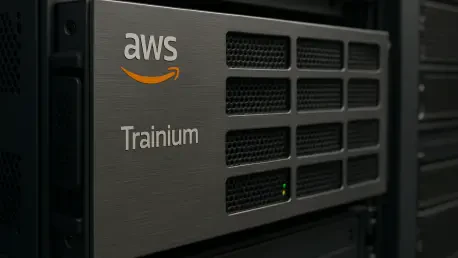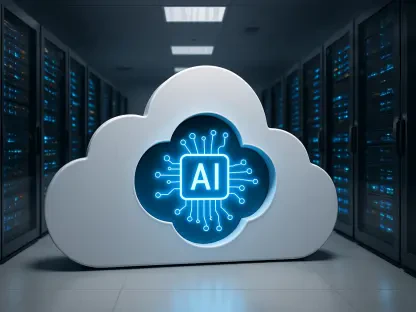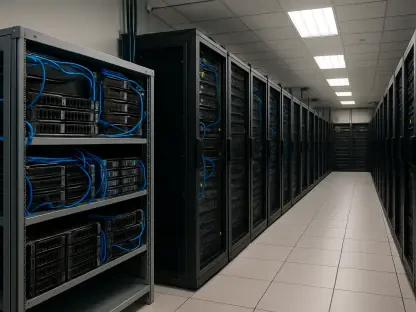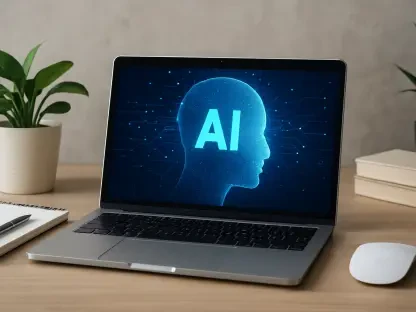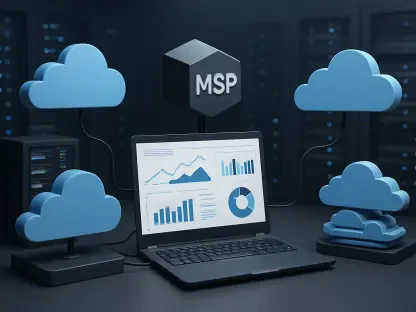In the fast-evolving landscape of artificial intelligence (AI), Amazon Web Services (AWS), the backbone of Amazon’s profitability, finds itself at a critical juncture, striving to reclaim its dominance in the cloud computing arena, especially within the burgeoning field of generative AI (GenAI). Historically a titan in traditional cloud services, AWS has faced stiff competition from Microsoft Azure and Google Cloud, both of whom have surged ahead in the AI cloud market by securing pivotal partnerships and deploying cutting-edge hardware tailored for AI workloads. This lag has not only impacted market share but also stirred concern among investors, evident in Amazon’s less impressive stock performance compared to its peers. However, a strategic alliance with Anthropic, a high-growth AI startup, coupled with massive infrastructure investments and the development of the custom Trainium chip, signals a bold attempt to turn the tide. The AI cloud market is a high-stakes battleground, with billions in potential revenue at play, and AWS is pulling out all the stops to position itself for a dramatic resurgence. This exploration delves into the challenges AWS faces, the innovative steps being taken to overcome them, and the potential for a redefined future in the competitive AI space.
Battling for Supremacy in the AI Cloud Arena
AWS has long been a cornerstone of Amazon’s financial success, contributing approximately 60% of the company’s profits through its dominance in cloud computing. Yet, in the era of GenAI, this leadership has been tested as competitors have outmaneuvered AWS in capturing the lucrative AI workload market. Microsoft Azure, bolstered by an exclusive partnership with OpenAI, has reaped over $10 billion in cloud spending from that alliance alone, setting a benchmark for success. Meanwhile, Google Cloud has leveraged its Tensor Processing Unit (TPU) technology to carve out a significant share of the market. AWS, by contrast, has struggled to keep pace in the critical GPU/XPU segment essential for AI processing, resulting in diminished growth and a perception of falling behind in innovation.
This competitive disadvantage stems from more than just technology—it reflects a strategic oversight in securing a major anchor customer early in the GenAI wave. Such customers are vital in the AI cloud space, driving substantial spending and validating a provider’s capabilities. The absence of such a partnership has left AWS vulnerable, with market analysts noting a clear gap in its ability to attract the kind of high-volume AI business that competitors have locked in. Investor confidence has wavered as a result, pushing AWS to rethink its approach. The response has been a decisive pivot toward forging game-changing alliances and building infrastructure at a scale unseen before, aiming to close the gap with rivals and reassert its position as a leader in the cloud domain.
Anthropic as the Catalyst for Revival
Central to AWS’s strategy for resurgence is its partnership with Anthropic, an AI startup that has emerged as a standout player in the GenAI landscape. With a remarkable fivefold revenue increase to an annualized $5 billion, Anthropic has demonstrated growth that outstrips many of its peers, making it a prized ally for AWS. Amazon’s commitment of up to $8 billion in investments has solidified AWS as Anthropic’s primary training partner since late last year, mirroring the kind of anchor relationship that has propelled Microsoft Azure to new heights. This alliance is seen as a linchpin for AWS, offering a pathway to recapture lost ground in the AI market.
However, the partnership is not without its complexities. While Anthropic’s growth is impressive, its cloud spending remains smaller than that of some competitors’ key partners, such as OpenAI with Azure. Additionally, a significant portion of Anthropic’s expenditure continues to flow to Google Cloud, an early investor and still a preferred provider for certain workloads. This divided loyalty poses a challenge for AWS, which must focus on maximizing its share of Anthropic’s training needs while competing for a larger slice of the startup’s overall cloud budget. The dynamic underscores the delicate balance AWS must strike to fully capitalize on this relationship and transform it into a definitive competitive advantage.
Unprecedented Infrastructure for AI Dominance
To meet the demands of Anthropic’s rapid scaling, AWS is embarking on an ambitious expansion of its datacenter capacity, constructing facilities with over 1.3 gigawatts of IT power dedicated to AI training. These campuses, among the largest of their kind, are designed to accommodate nearly a million Trainium2 chips, custom-built accelerators tailored for AI workloads. The sheer scale of this buildout reflects AWS’s determination to stay ahead in the race for AI supremacy, ensuring it can support the computational needs of cutting-edge GenAI models. The speed at which these facilities are being developed is noteworthy, signaling an urgency to match the pace of innovation in the industry.
Yet, this massive undertaking comes with inherent risks and delays. Revenue generation from these new datacenters is not expected until late this year due to assembly challenges with the Trainium chips, highlighting the complexities of deploying unproven technology at such an expansive scale. While the infrastructure promises to be a game-changer once operational, the interim period of waiting poses short-term financial pressures. Nevertheless, the potential rewards are substantial—if AWS can navigate these hurdles, the payoff could redefine its standing in the AI cloud market, positioning it as a formidable force capable of supporting the most demanding AI applications.
Trainium2: Redefining Cost and Capability
At the core of AWS’s technological push is Trainium2, the third-generation AI accelerator designed to compete with industry giants like Nvidia’s GPUs and Google’s TPUs. While its raw performance metrics, such as 667 TFLOP/s, fall short of Nvidia’s 2500 TFLOP/s, Trainium2 offers a compelling edge in total cost of ownership (TCO), particularly for memory-intensive workloads like reinforcement learning, which are central to Anthropic’s research focus. This cost efficiency makes it an attractive option for large-scale AI training, where expenses can quickly spiral, providing AWS with a unique selling point in a crowded market.
Beyond mere numbers, Trainium2 represents a shift toward deeper collaboration between hardware and software. Anthropic’s active involvement in the chip’s design process mirrors strategies seen in other leading AI labs, such as Google DeepMind, where tailored solutions yield optimized performance. This co-design approach could position Anthropic—and by extension AWS—at a distinct advantage, allowing for hardware that aligns precisely with specific AI needs. For AWS, Trainium2 is more than just a piece of silicon; it’s a strategic tool aimed at differentiating its offerings and carving out a niche in the highly competitive landscape of AI accelerators, potentially reshaping how cloud providers support GenAI innovation.
Navigating Technical and Competitive Obstacles
Despite the promise of Trainium2 and the Anthropic partnership, AWS faces notable technical challenges that could impede its progress. The Elastic Fabric Adapter (EFA), AWS’s custom networking fabric, lags behind industry standards like Nvidia’s InfiniBand, creating bottlenecks in performance for multi-tenant GPU clusters. This shortfall has impacted AWS’s ability to attract smaller customers who rely on flexible, high-performing environments, as reflected in industry evaluations like the ClusterMAX system by SemiAnalysis. Such weaknesses highlight a broader struggle to match the seamless integration and user experience offered by competitors.
Compounding these issues are gaps in Trainium’s broader system architecture, particularly in scale-up network bandwidth, where it continues to trail Nvidia’s cutting-edge solutions. Even with promising updates on the horizon, such as the Teton PDS framework, AWS must address these deficiencies to compete across all market segments. While anchor customers like Anthropic prioritize scale and pricing over software sophistication, the broader market demands versatility that AWS has yet to fully deliver. Overcoming these hurdles will be critical if AWS is to transform its focused successes into a comprehensive competitive resurgence in the AI cloud space.
Charting the Future of AWS in AI Innovation
Looking ahead, the trajectory for AWS appears cautiously optimistic, with projections indicating growth surpassing 20% year-over-year by the close of this year. This anticipated upswing is largely tied to the ramp-up of Anthropic’s training expenditures and the successful rollout of Trainium deployments across new datacenters. Should these elements align as planned, AWS could reclaim a leading position in the AI cloud market, leveraging its strategic investments to outpace rivals who have dominated recent years. The potential for such a turnaround is a testament to the bold vision driving AWS’s current efforts.
However, significant risks remain on the horizon. Anthropic’s continued reliance on Google Cloud for inference workloads, where TPUs hold a strong advantage, means AWS does not yet command the startup’s full cloud spending. This split allegiance could dilute the impact of AWS’s investments. Furthermore, sustaining momentum will require expanding Trainium’s appeal to new customers beyond Anthropic and enhancing internal GenAI initiatives like Bedrock. The path forward demands a multifaceted approach—addressing technical shortcomings, securing additional high-value partnerships, and diversifying revenue streams to ensure that AWS not only catches up but sets a new standard for innovation in the fiercely contested AI landscape.
